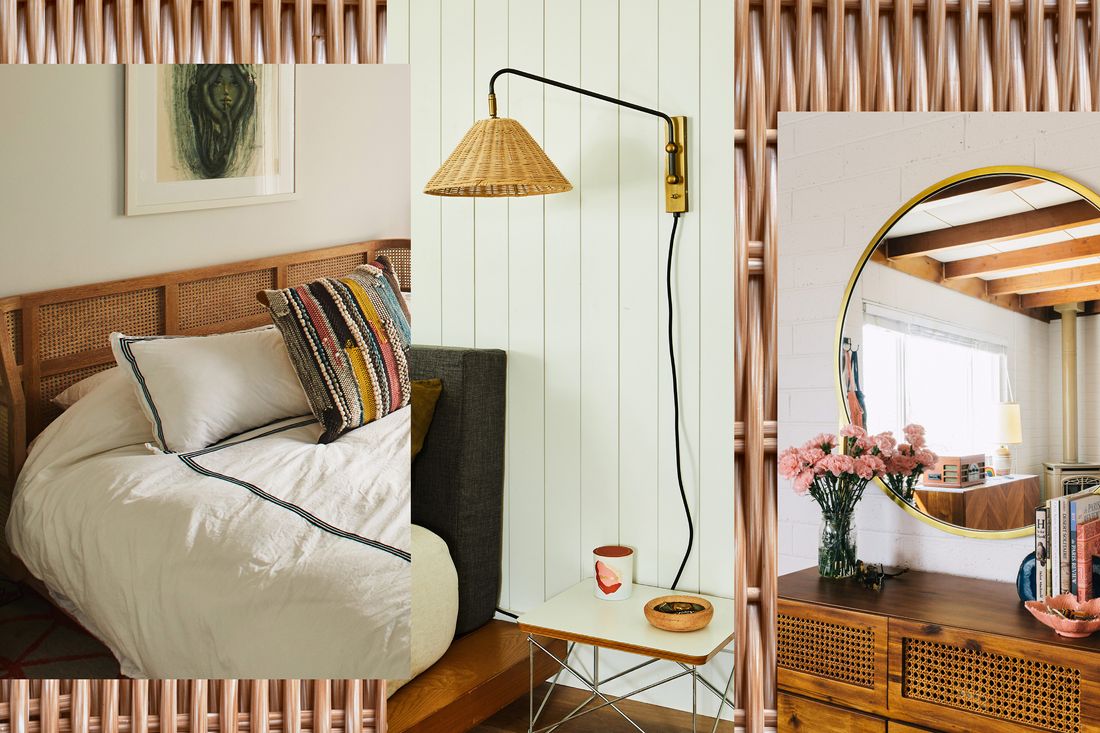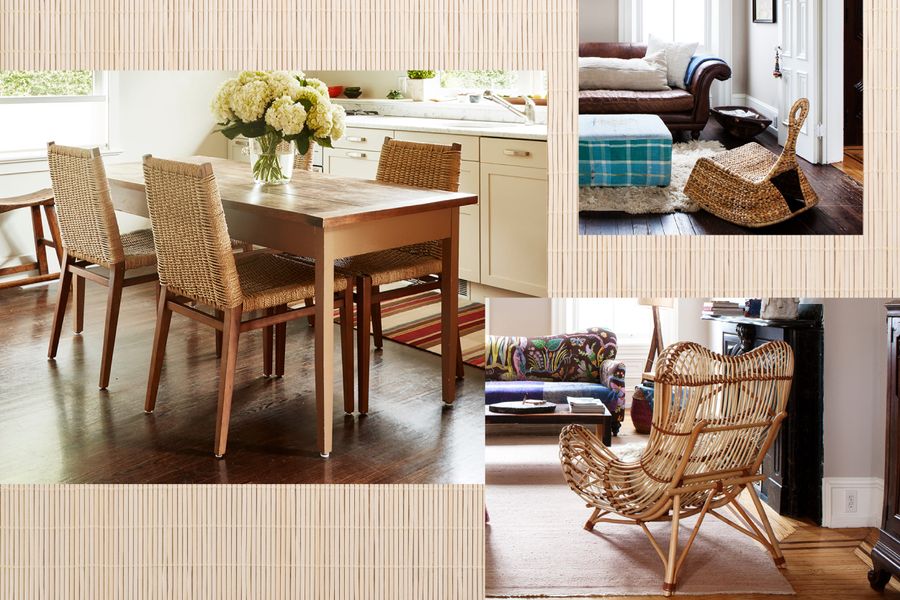
This story was originally published by Curbed before it joined New York Magazine. You can visit the Curbed archive at archive.curbed.com to read all stories published before October 2020.
Some textures are so ingrained in our visual vocabulary that they act as neutrals. Like glossy white subway tile or the sprightly tail of a pothos plant, the six-way honeycomb pattern most associated with cane furniture exists in a room without distracting from it. Cane, which can be woven into virtually anything, is a material that complements: It makes a room look better, more pulled together, more thoughtful than a simpler, denser material would.
In the past few years, cane products have appeared from retailers catering to all budgets — upmarket designers like Kam Ce Kam, but also Target and H&M. CB2 sells cane daybeds and mirrors. Urban Outfitters has a whole line of cane furniture, which includes armoires and wall shelves. Direct-to-consumer brand Industry West has one, too. Cane has appeared in a number of public spaces: take the oversized armchairs in the Manhattan waiting room of “healthcare membership” Parsley Health, and the translucent, half-glass doors at a tea house from lifestyle brand Genshang in Shanghai. This past summer, a coworking space opened inside Raffles, the iconic Singapore hotel, featuring cane chairs and bars. This material makes sense for tropical locations, but cane appears more often than you might think in temperate-climate office spaces, too, including the Nest in Warsaw and Public Hall in London. In restaurants, cane is a key ingredient in seating, like the bentwood chairs at all-day cafe Lou, in Nashville, but it has other uses, too, as in the New York dining rooms of Fausto (room dividers) and King (window sashes).
Unlike many of the textures that populate our interiors (poly-blend blankets, particle-board tables, steel table legs with a brass finish), the cane available at most retailers, as one component of furniture or decor, is actually an organic, unmediated material. Cane is the outer part of the rattan tree, which grows like a vine in thick, winding strands. The inner core of the rattan vine is one of several materials, along with bamboo, willow, and raffia, that, when woven, falls under the larger classification of wicker. Despite its close relationship with the category, cane doesn’t share wicker’s chintzy connotation.
Six-way cane, which has come back into fashion and Instagram feeds recently, is a manmade pattern woven from strips of rattan bark. It provides a springy, supportive alternative to cumbersome upholstery or hard (and expensive) solid wood seats. To create a panel of cane, you begin with a frame with holes along the perimeter. You then thread two strips of cane from the front to back, two strips from side to side, and two more diagonally. Once woven, sometimes cane is paired with steel, but more often, panels of it appear in wood frames on things like space dividers, armoire doors, nightstand drawers, and headboards. It lightens any design, replacing what would have been an opaque piece of wood with a light-diffusing, eye-catching pattern.
The flexibility of cane — both physically and stylistically — is its greatest asset. It feels less disposable than other materials used to make furniture. And it is. When cane panels break, they can be repaired. There are no springs, stuffing, or pieces of wood to source. Cane strips or pre-woven sheets of webbing are uniform and easy to find. It’s a pliable material that gives a touch of “naturalness” to any setting, something especially appealing in tech-filled spaces. Like linen, another of-the-moment material with tropical connotations that feels equally fitting in a city apartment, cane softens a space. Its organic look is a visual palate cleanser after a long day of pecking and staring at plastic and metal. Cane catches your eye, then does little else.
Cane chairs are a product of colonialism in a literal sense. As Jordan Sand writes in Tropical Furniture and Bodily Comportment in Colonial Asia, rattan and its byproduct, cane, were used widely by native populations in Southeast Asia to construct everything from hats to houses. But cane furniture was not a common feature in these homes, where floor-sitting was the norm. Instead, Chinese and European colonists, with their chair-sitting traditions, had a need for seating in the lands they colonized, and satisfied it using readily available material: rattan.
Rattan originally arrived in the Western world as packing material for more valuable goods like spices and tea imported from Asia by the East India Company starting in the 17th century. It’s unclear when craftsmen in England started weaving cane in the six-way pattern, but there’s evidence that this technique existed in China since at least 250 B.C. In 1950, archaeologists at an ancient tomb site in the Yellow River Valley uncovered a fragment of six-way cane between layers of sand. The scrap was so fragile that it disintegrated when the area was excavated, but the pattern left a six-way impression on a nearby piece of clay, like a shred of a Dior bag. (Cannage has been a motif in Christian Dior designs since the 1950s, a reference to the Napoléon III-style cane chairs the designer used to seat guests at his early fashion shows.)
Thanks in part to the sleekness of Marcel Breuer’s Cesca chair, cane has a more modern connotation than other members of the wicker family. You’ve probably seen the Cesca chair, or at least a version of it. It has rounded edges and a cantilevered, tubular steel frame. Food writer Alison Roman has a set in her dining room (you can see glimpses of them in her Into the Gloss Top Shelf interview and the B-roll of her New York Times Thanksgiving video). They’ve almost become a category of seating rather than a style, an alternative to heavy, four-footed wooden chairs or fiberglass shells.
Cesca chairs weren’t made to go with any particular table, or in any particular room. The design came out of the Bauhaus in 1928, but didn’t take hold in America until after World War II, and even then, it was a kind of architectural darling. Sam Kaufman, owner of a midcentury furniture gallery in Los Angeles, tells me that in the 1960s and early ’70s, you’d see Cesca chairs in Architectural Digest, as part of “sophisticated dining rooms,” but they weren’t yet a mass product. But by the late 1970s and ’80s, less expensive versions of the chair (the design was never patented) started to appear in American workspaces and homes. There’s a set of Cesca chairs in a kitchen in Woody Allen’s 1978 film Interiors and a single chair opposite a mid-level employee’s desk in Albert Brooks’s 1985 yuppie satire Lost in America. In the span of a decade, the chair had become shorthand for conformity. The Cesca chair, wrote Washington Post architecture critic Sarah Booth Conroy in 1981, “is in almost every breakfast room today, as the Thonet chair was in every cafe at the turn of the century.”
You’ve probably seen a Thonet chair, too. It’s made with bentwood and cane, and like the Cesca, its design is ageless and often imitated. There are a number of variations, but each has a lithe, curved back and a round seat. The legs flare out slightly, like petals on a bellflower. Thonet chairs, designed by German-born cabinetmaker Michael Thonet, were exported from Vienna starting in the 1850s. As Witold Rybczynski writes in Now I Sit Me Down: From Klismos to Plastic Chair: A Natural History, Thonet developed a technique to bend whole pieces of wood, which could be shipped flat in bulk. In effect, Thonet created the first mass-produced, flat-packed furniture. Like the Cesca chair, Thonet chairs were a late bloomer in home design, and enjoyed an “unexpected revival” in the 1920s, when French architect Le Corbusier started using them in his drawings and exhibitions. And like the Cesca chair, bentwood furniture also had a (second) comeback in the 1970s.
Though cane has a long history in interiors prior to Thonet’s designs of the 1850s, it benefited significantly from industrialization, which made it possible to create furniture on a large scale relatively inexpensively. It’s no accident that two of the most widely produced seats of the last two centuries are made with six-way cane. The inherent quality of the material, paired with the attractive, simple designs that employed it, helped make cane furniture a global product.
Today, most of the world’s cane comes from Indonesia. It is then mechanically manufactured in China and brought to the United States through one of two major importers, both located on Long Island. Veterans Caning is a family-owned repair and service business that’s been in Manhattan since 1899. Sean Bausert, who now runs the operation, says that, despite the ebb and flow of home decor trends, there’s always been a consistent market for caning services. Classic cane can fit into any setting, and it’s been used on furniture in many different styles for hundreds of years. People tend to keep cane furniture, Bausert says, and repair it rather than get rid of it. It makes sense that cane is one of those things — like hoop earrings or serif fonts — that always seems to be in the midst of a revival. “Now that the old-fashioned cane furniture has become new-fashioned and is so popular, homemakers are resurrecting from the garret and cellar their old broken cane chairs.” That’s from a 1933 educational brochure on chair repair.
Mechanized weaving has existed in this country since the middle of the 19th century, but there’s still a small, strong community of handweavers across the world, many of whom are now connected through the internet. One of these weavers is Brandy Clements, who, along with her husband, David Klingler, owns and operates the Silver River Center for Chair Caning, located in Asheville’s River Arts District. In recent years, she says, she’s had more young people take her classes as cane has gained popularity, including a good number of international visitors. People have come from as far as France and Tasmania to learn how to weave at her center near the Great Smoky Mountains.
Why is there so much interest in cane now? Perhaps it’s because cane furniture offers a vision of the future that’s grounded in natural materials. The success of the Cesca chair, as opposed to other Bauhaus designs, is its ability to blend the old and the new. An ancient material (cane) comes together with an almost absurdly modern one (tubular steel) to create something that’s comfortable, attractive, and durable. It’s an emblem of mass-produced handiwork.
It helps, too, that cane is more interesting to look at than wood laminate. People tend to dress their rooms the way they dress themselves. Combining style reference points has become de rigueur in fashion and interior design. Few people wear head-to-toe designer anything anymore, much less stick to one decade for inspiration (you can wear a scrunchie, but it’s best not to pair it with a sweatshirt). Instead, you pick and choose the elements of past fashions that appeal to you.
Cane appeals to many because its reference points are so muddled. It’s hard to pin down, and that’s what people like about it. It works in a space without defining it. It makes sense, in a room that may have a flat-screen television along one wall and a cushy, tufted sectional on the other, to create a focal point that’s less reflective, less imposing, and more old-fashioned.
Rachel del Valle is a writer living in Los Angeles. Her last story for Curbed was about velvet.







